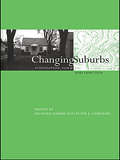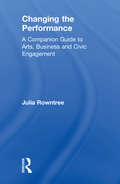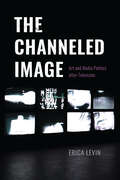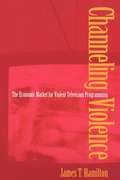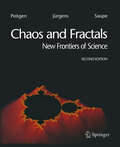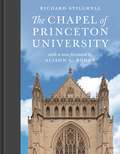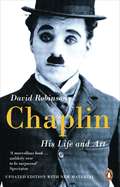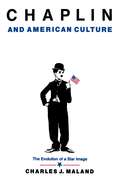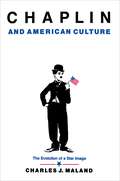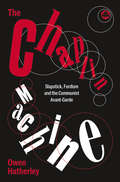- Table View
- List View
Changing Suburbs: Foundation, Form and Function
by Richard Harris Peter LarkhamThe editors and contributors to this volume demonstrate how suburbs and the meaning of suburbanism change both with time and geographical location.Here the disciplines of history, geography and sociology, together with subdisciplines as diverse as gender studies, art history and urban morphology, are brought together to reveal the nature of suburbia from the nineteenth century to the present day.
Changing Television Environments: 6th European Conference, EuroITV 2008, Salzburg, Austria, July 3-4, 2008, Proceedings (Lecture Notes in Computer Science #5066)
by Manfred Tscheligi Marianna Obrist Arthur LugmayrThis book constitutes the refereed proceedings of the 6th European Conference on Interactive Television, EuroITV 2008, held in Salzburg, Austria, in July 2008. The 42 revised full papers were carefully reviewed and selected from 156 submissions. The contributions cover significant aspects of the interactive television domain including submissions on user studies, technical challenges related to new developments as well as new kind of formats. The papers are organized in topical sections on interactive TV, interactive authoring, personalisation and recommender systems, mobile TV, social TV, new TV environments, iTV architectures and systems, user interfaces and interaction design, user studies, and accessibility.
Changing the Performance: A Companion Guide to Arts, Business and Civic Engagement
by Julia RowntreeA result of many years of research and practice, Changing the Performance is a book about the arts and about business, and the interplay between the two. Julia Rowntree gives a fascinating account of her experiences forging the business sponsorship campaign at the London International Festival of Theatre (LIFT). Raising intriguing questions, this book proposes that fundraising for the arts is much more than simply a function for generating income. It fulfils an ancient social role of connection across levels of power, expertise, culture, gender and generation. Rowntree describes why these dynamics are vital to society's ability to adapt. Changing the Performance is an inspiring manual for arts practitioners concerned with the relationship between business, the arts and wider society, and particularly those engaged in fundraising.
Changing the Performance: A Companion Guide to Arts, Business and Civic Engagement
by Julia RowntreeA result of many years of research and practice, Changing the Performance is a book about the arts and about business, and the interplay between the two. Julia Rowntree gives a fascinating account of her experiences forging the business sponsorship campaign at the London International Festival of Theatre (LIFT). Raising intriguing questions, this book proposes that fundraising for the arts is much more than simply a function for generating income. It fulfils an ancient social role of connection across levels of power, expertise, culture, gender and generation. Rowntree describes why these dynamics are vital to society's ability to adapt. Changing the Performance is an inspiring manual for arts practitioners concerned with the relationship between business, the arts and wider society, and particularly those engaged in fundraising.
Changing Things: The Future of Objects in a Digital World
by Johan Redström Heather WiltseMany of the things we now live with do not take a purely physical form. Objects such as smart phones, laptops and wearable fitness trackers are different from our things of the past. These new digital forms are networked, dynamic and contextually configured. They can be changeable and unpredictable, even inscrutable when it comes to understanding what they actually do and whom they really serve.In this compelling new volume, Johan Redstrom and Heather Wiltse address critical questions that have assumed a fresh urgency in the context of these rapidly-developing forms. Drawing on critical traditions from a range of disciplines that have been used to understand the nature of things, they develop a new vocabulary and a theoretical approach that allows us to account for and address the multi-faceted, dynamic, constantly evolving forms and functions of contemporary things. In doing so, the book prototypes a new design discourse around everyday things, and describes them as fluid assemblages.Redstrom and Wiltse explore how a new theoretical framework could enable a richer understanding of things as fluid and networked, with a case study of the evolution of music players culminating in an in-depth discussion of Spotify. Other contemporary 'things' touched on in their analysis include smart phones and watches, as well as digital platforms and applications such as Google, Facebook and Twitter.
Changing Things: The Future of Objects in a Digital World
by Johan Redström Heather WiltseMany of the things we now live with do not take a purely physical form. Objects such as smart phones, laptops and wearable fitness trackers are different from our things of the past. These new digital forms are networked, dynamic and contextually configured. They can be changeable and unpredictable, even inscrutable when it comes to understanding what they actually do and whom they really serve.In this compelling new volume, Johan Redstrom and Heather Wiltse address critical questions that have assumed a fresh urgency in the context of these rapidly-developing forms. Drawing on critical traditions from a range of disciplines that have been used to understand the nature of things, they develop a new vocabulary and a theoretical approach that allows us to account for and address the multi-faceted, dynamic, constantly evolving forms and functions of contemporary things. In doing so, the book prototypes a new design discourse around everyday things, and describes them as fluid assemblages.Redstrom and Wiltse explore how a new theoretical framework could enable a richer understanding of things as fluid and networked, with a case study of the evolution of music players culminating in an in-depth discussion of Spotify. Other contemporary 'things' touched on in their analysis include smart phones and watches, as well as digital platforms and applications such as Google, Facebook and Twitter.
Channel 4: A History: from Big Brother to The Great British Bake Off
by Maggie BrownThis book covers a dramatic decade in the fortunes of Britain's quirkiest broadcaster. It opens in 2009, with the realisation that Channel 4's biggest money spinner, Big Brother, had become a toxic asset and would have to be discarded, at the same time as advertising revenues were shrinking in the wake of the 2008 financial crash. Maggie Brown's compelling narrative, which draws on interviews with key players in Channel 4's story and unique access to the broadcaster's archives, takes us inside the boardroom battles, changes in senior management and commissioning teams, interventions by the media regulator Ofcom, and the channel's response to a rapidly-changing media and political landscape. Brown describes how the channel, under its new chief executive David Abraham, successfully fought off the threat of privatisation, which became a reality after the Conservatives' general election victory in 2015. The price for remaining publicly funded was a substantial relocation of Channel 4's operations, with Leeds announced in 2018 as a new 'regional hub'. The Channel 4 story is also one of ambitious and innovative programming, with a new director of content, Jay Hunt, instigating radical changes in commissioning and scheduling. Brown traces programming hits and losses during this period, with the departure to competitors of celebrity chefs, Black Mirror and Charlie Brooker, horse racing and Formula 1, and a reappraisal of the remit of institutions such as Channel 4 News and Film 4. But there were successes too, with the 2012 Paralympics helping to restore a public service sheen, and new programmes such as Gogglebox in 2013 connecting with younger audiences, and, in 2016, the coup of taking The Great British Bake Off from its home at the BBC.
Channel 4: A History: from Big Brother to The Great British Bake Off
by Maggie BrownThis book covers a dramatic decade in the fortunes of Britain's quirkiest broadcaster. It opens in 2009, with the realisation that Channel 4's biggest money spinner, Big Brother, had become a toxic asset and would have to be discarded, at the same time as advertising revenues were shrinking in the wake of the 2008 financial crash. Maggie Brown's compelling narrative, which draws on interviews with key players in Channel 4's story and unique access to the broadcaster's archives, takes us inside the boardroom battles, changes in senior management and commissioning teams, interventions by the media regulator Ofcom, and the channel's response to a rapidly-changing media and political landscape. Brown describes how the channel, under its new chief executive David Abraham, successfully fought off the threat of privatisation, which became a reality after the Conservatives' general election victory in 2015. The price for remaining publicly funded was a substantial relocation of Channel 4's operations, with Leeds announced in 2018 as a new 'regional hub'. The Channel 4 story is also one of ambitious and innovative programming, with a new director of content, Jay Hunt, instigating radical changes in commissioning and scheduling. Brown traces programming hits and losses during this period, with the departure to competitors of celebrity chefs, Black Mirror and Charlie Brooker, horse racing and Formula 1, and a reappraisal of the remit of institutions such as Channel 4 News and Film 4. But there were successes too, with the 2012 Paralympics helping to restore a public service sheen, and new programmes such as Gogglebox in 2013 connecting with younger audiences, and, in 2016, the coup of taking The Great British Bake Off from its home at the BBC.
Channel 4: The Early Years and the Jeremy Isaacs Legacy
by Dorothy HobsonIn November 2007, Channel 4 will be twenty-five years old. Today, such tv events as the 'Big Brother/Jade Goody affair' have put the channel itself at the centre of public debate. Yet during its foundation years on British screens, Channel 4 was seen as more controversial and dangerous than this. Published for Channel 4's 25th anniversary, this book explores the channel's most important foundation period, under its inspirational first Chief Executive, Jeremy Isaacs. Charged by Parliament to be innovative, experimental, and educational, the new channel had to attract audiences and make a space for new voices. Did it fulfill its brief? It also assesses the legacy of the channel and asks: has it changed the nature of British television, and has the enfant terrible grown up, or is it still a youthful rebel?Dorothy Hobson had unique access to Channel 4 and the team involved in developing it, the ITV companies and fledgling independent producers over its foundation years. Accessibly written, her book uses the words and stories of those involved, and vividly reviews the new channel's successes, problems, adversities, as well as audiences' and press responses to television's new baby and its programmes.
The Channeled Image: Art and Media Politics after Television
by Erica LevinA fascinating look at artistic experiments with televisual forms. Following the integration of television into the fabric of American life in the 1950s, experimental artists of the 1960s began to appropriate this novel medium toward new aesthetic and political ends. As Erica Levin details in The Channeled Image, groundbreaking artists like Carolee Schneemann, Bruce Conner, Stan VanDerBeek, and Aldo Tambellini developed a new formal language that foregrounded television’s mediation of a social order defined by the interests of the state, capital, and cultural elites. The resulting works introduced immersive projection environments, live screening events, videographic distortion, and televised happenings, among other forms. For Levin, “the channeled image” names a constellation of practices that mimic, simulate, or disrupt the appearance of televised images. This formal experimentation influenced new modes of installation, which took shape as multi-channel displays and mobile or split-screen projections, or in some cases, experimental work produced for broadcast. Above all, this book asks how artistic experimentation with televisual forms was shaped by events that challenged television broadcasters’ claims to authority, events that set the stage for struggles over how access to the airwaves would be negotiated in the future.
The Channeled Image: Art and Media Politics after Television
by Erica LevinA fascinating look at artistic experiments with televisual forms. Following the integration of television into the fabric of American life in the 1950s, experimental artists of the 1960s began to appropriate this novel medium toward new aesthetic and political ends. As Erica Levin details in The Channeled Image, groundbreaking artists like Carolee Schneemann, Bruce Conner, Stan VanDerBeek, and Aldo Tambellini developed a new formal language that foregrounded television’s mediation of a social order defined by the interests of the state, capital, and cultural elites. The resulting works introduced immersive projection environments, live screening events, videographic distortion, and televised happenings, among other forms. For Levin, “the channeled image” names a constellation of practices that mimic, simulate, or disrupt the appearance of televised images. This formal experimentation influenced new modes of installation, which took shape as multi-channel displays and mobile or split-screen projections, or in some cases, experimental work produced for broadcast. Above all, this book asks how artistic experimentation with televisual forms was shaped by events that challenged television broadcasters’ claims to authority, events that set the stage for struggles over how access to the airwaves would be negotiated in the future.
Channeling Violence: The Economic Market for Violent Television Programming (PDF)
by James T. Hamilton"If it bleeds, it leads." The phrase captures television news directors' famed preference for opening newscasts with the most violent stories they can find. And what is true for news is often true for entertainment programming, where violence is used as a product to attract both viewers and sponsors. In this book, James Hamilton presents the first major theoretical and empirical examination of the market for television violence. Hamilton approaches television violence in the same way that other economists approach the problem of pollution: that is, as an example of market failure. He argues that television violence, like pollution, generates negative externalities, defined as costs borne by others than those involved in the production activity. Broadcasters seeking to attract viewers may not fully bear the costs to society of their violent programming, if those costs include such factors as increased levels of aggression and crime in society. Hamilton goes on to say that the comparison to pollution remains relevant when considering how to deal with the problem. Approaches devised to control violent programming, such as restricting it to certain times and rating programs according to the violence they contain, have parallels in zoning and education policies designed to protect the environment. Hamilton examines in detail the microstructure of incentives that operate at every level of television broadcasting, from programming and advertising to viewer behavior, so that remedies can be devised to reduce violent programming without restricting broadcasters' right to compete.
Channeling Violence: The Economic Market for Violent Television Programming
by James T. Hamilton"If it bleeds, it leads." The phrase captures television news directors' famed preference for opening newscasts with the most violent stories they can find. And what is true for news is often true for entertainment programming, where violence is used as a product to attract both viewers and sponsors. In this book, James Hamilton presents the first major theoretical and empirical examination of the market for television violence. Hamilton approaches television violence in the same way that other economists approach the problem of pollution: that is, as an example of market failure. He argues that television violence, like pollution, generates negative externalities, defined as costs borne by others than those involved in the production activity. Broadcasters seeking to attract viewers may not fully bear the costs to society of their violent programming, if those costs include such factors as increased levels of aggression and crime in society. Hamilton goes on to say that the comparison to pollution remains relevant when considering how to deal with the problem. Approaches devised to control violent programming, such as restricting it to certain times and rating programs according to the violence they contain, have parallels in zoning and education policies designed to protect the environment. Hamilton examines in detail the microstructure of incentives that operate at every level of television broadcasting, from programming and advertising to viewer behavior, so that remedies can be devised to reduce violent programming without restricting broadcasters' right to compete.
Chantal Akerman (French Film Directors Series)
by Marion SchmidChantal Akerman is widely acclaimed as one of the most original and important directors working in Europe today. A towering figure in women’s and feminist film-making, she has produced a diverse and intensely personal body of work ranging from minimalist portraits of the everyday to exuberant romantic comedies, and from documentaries and musicals to installation art. This book traces the director’s career at the crossroads between experimental and mainstream cinema, contextualising her work within the American avant-garde of the 1970s, European anti-naturalism, feminism and the post-modern aesthetics. While offering an in-depth analysis of her multi-faceted film style, it also stresses the social and ethical dimension of her work, especially as regards her representation of marginal groups and her exploration of exilic and diasporic identities. Particular attention is given to the inscription of the Holocaust and of Jewish memory in her films.
Chaos and Fractals: New Frontiers of Science
by Heinz-Otto Peitgen Hartmut Jürgens Dietmar SaupeThe fourteen chapters of this book cover the central ideas and concepts of chaos and fractals as well as many related topics including: the Mandelbrot set, Julia sets, cellular automata, L-systems, percolation and strange attractors. This new edition has been thoroughly revised throughout. The appendices of the original edition were taken out since more recent publications cover this material in more depth. Instead of the focussed computer programs in BASIC, the authors provide 10 interactive JAVA-applets for this second edition.
Chaos and Fractals: A Computer Graphical Journey
by C. A. PickoverThese days computer-generated fractal patterns are everywhere, from squiggly designs on computer art posters to illustrations in the most serious of physics journals. Interest continues to grow among scientists and, rather surprisingly, artists and designers. This book provides visual demonstrations of complicated and beautiful structures that can arise in systems, based on simple rules. It also presents papers on seemingly paradoxical combinations of randomness and structure in systems of mathematical, physical, biological, electrical, chemical, and artistic interest. Topics include: iteration, cellular automata, bifurcation maps, fractals, dynamical systems, patterns of nature created through simple rules, and aesthetic graphics drawn from the universe of mathematics and art.Chaos and Fractals is divided into six parts: Geometry and Nature; Attractors; Cellular Automata, Gaskets, and Koch Curves; Mandelbrot, Julia and Other Complex Maps; Iterated Function Systems; and Computer Art.Additionally, information on the latest practical applications of fractals and on the use of fractals in commercial products such as the antennas and reaction vessels is presented. In short, fractals are increasingly finding application in practical products where computer graphics and simulations are integral to the design process. Each of the six sections has an introduction by the editor including the latest research, references, and updates in the field. This book is enhanced with numerous color illustrations, a comprehensive index, and the many computer program examples encourage reader involvement.
Chapaev: Kinofile Filmmakers' Companion 12 (KINOfiles Film Companion)
by Julian GraffyChapaev' is the most popular film of the Soviet era. Directed by Georgi and Sergei Vasilev, it tells of the legendary exploits of the Red Army Commander Vasili Ivanovich Chapaev during the Russian Civil War. Its greatest fan was Joseph Stalin, who saw it 38 times at late-night showings in the Kremlin. It was both praised by Party ideologues for its faithfulness to the Bolshevik cause and loved by mass audiences for its adventure sequences and its tragic love story. For over seventy years, Chapaev, Furmanov the Commissar, Petka and Anka have remained heroes of the Russian popular imagination.This illuminating and enjoyable companion tells the story of the real-life Chapaev, of the novel by Dmitri Furmanov, and of the struggles to make the film. Julian Graffy offers a detailed analysis of the film itself and then considers Chapaev's extraordinary after-life. The film provoked poetry by Osip Mandelstam and a novel by Viktor Pelevin, operas and scabrous popular anecdotes. Graffy shows that to understand Chapaev's appeal is to understand something about what it means to be Russian.
The Chapel of Princeton University
by Richard StillwellThe classic guide to one of America's architectural treasures—now with magnificent new color photos and a foreword by Princeton's dean of religious lifeLike the medieval English cathedrals that inspired it, the Princeton University Chapel is an architectural achievement designed to evoke wonder, awe, and reflection. Richard Stillwell's The Chapel of Princeton University is the essential illustrated guide to this magnificent architectural and cultural landmark.Now with new color photos throughout, The Chapel of Princeton University traces the history of the chapel and describes its architecture, sculpture, woodwork, and furnishings. Stillwell knew the building from its planning stages through its construction, dedication, and long use. In this book, he offers unique insights into the vision of architect Ralph Adams Cram and the artistry of Charles J. Connick, who designed the chapel's breathtaking cycle of stained-glass windows. Stillwell's thoroughly researched account of the glorious stone, wood, and glasswork gives readers and visitors an opportunity to enjoy the chapel as both an aesthetically beautiful structure and a moving religious statement. Stillwell reveals how the building's composition is meant to provide spiritual access to as many seekers as possible and instill in them an extraordinary message of hope.Featuring a foreword by Alison Boden, Princeton's dean of religious life, The Chapel of Princeton University is a guided tour of an inspiring structure that has served as the spiritual home to one of America's leading universities.
The Chapel of Princeton University
by Richard StillwellThe classic guide to one of America's architectural treasures—now with magnificent new color photos and a foreword by Princeton's dean of religious lifeLike the medieval English cathedrals that inspired it, the Princeton University Chapel is an architectural achievement designed to evoke wonder, awe, and reflection. Richard Stillwell's The Chapel of Princeton University is the essential illustrated guide to this magnificent architectural and cultural landmark.Now with new color photos throughout, The Chapel of Princeton University traces the history of the chapel and describes its architecture, sculpture, woodwork, and furnishings. Stillwell knew the building from its planning stages through its construction, dedication, and long use. In this book, he offers unique insights into the vision of architect Ralph Adams Cram and the artistry of Charles J. Connick, who designed the chapel's breathtaking cycle of stained-glass windows. Stillwell's thoroughly researched account of the glorious stone, wood, and glasswork gives readers and visitors an opportunity to enjoy the chapel as both an aesthetically beautiful structure and a moving religious statement. Stillwell reveals how the building's composition is meant to provide spiritual access to as many seekers as possible and instill in them an extraordinary message of hope.Featuring a foreword by Alison Boden, Princeton's dean of religious life, The Chapel of Princeton University is a guided tour of an inspiring structure that has served as the spiritual home to one of America's leading universities.
Chapel Street (Oberon Modern Plays)
by Luke Barnes‘If I died tomorrow, I would have died having done nothing. So I made a promise there and then that we would live tonight like it was our last’ He’s been let down, belittled and ignored but tonight none of that matters – it’s Friday and Joe is getting smashed. Kirsty has bought some vodka on the way home from school and is hastily shaving her legs with her friend’s dad’s razor. As bottles are drained and the sun sets the two hit the town, neither aware that soon their lives will irreconcilably collide. Chapel Street is the debut play from one of the UK’s most exciting new writers, Luke Barnes. Crackling with energy and dripping with humour it is an acerbic yet compassionate portrait of good times gone bad for a betrayed generation, which carries a pertinence in the wake of David Cameron addressing ‘Broken Britain’.
Chaplin: His Life And Art (Paladin Bks.)
by David RobinsonDavid Robinson's definitive and monumental biography of Charlie Chaplin, the greatest icon in the history of cinema, who lived one of the most dramatic rags to riches stories ever told. Chaplin's life was marked by extraordinary contrasts: the child of London slums who became a multimillionaire; the on-screen clown who was a driven perfectionist behind the camera; the adulated star who publicly fell from grace after personal and political scandal. This engrossing and definitive work, written with full access to Chaplin's archives, tells the whole story of a brilliant, complex man. David Robinson is a celebrated film critic and historian who wrote for The Times and the Financial Times for several decades. His many books include World Cinema, Hollywood in the Twenties and Buster Keaton. 'A marvellous book . . . unlikely ever to be surpassed' Spectator 'I cannot imagine how anyone could write a better book on the great complex subject . . . movingly entertaining, awesomely thorough and profoundly respectful' Sunday Telegraph 'One of the great cinema books; a labour of love and a splendid achievement' Variety 'One of those addictive biographies in which you start by looking in the index for items that interest you . . . and as dawn breaks you're reading the book from cover to cover' Financial Times
Chaplin and American Culture: The Evolution of a Star Image (PDF)
by Charles J. MalandCharles Maland focuses on the cultural sources of the on-and-off, love-hate affair between Chaplin and the American public that was perhaps the stormiest in American stardom.
Chaplin and American Culture: The Evolution of a Star Image
by Charles J. MalandCharles Maland focuses on the cultural sources of the on-and-off, love-hate affair between Chaplin and the American public that was perhaps the stormiest in American stardom.
The Chaplin Machine: Slapstick, Fordism and the Communist Avant-Garde
by Owen HatherleyCould Buster Keaton have starred in Battleship Potemkin?*BR**BR*Did Trotsky plan to write the great Soviet comedy?*BR**BR*And why did Lenin love circus clowns?*BR**BR*The Chaplin Machine reveals the lighter side of the Communist avant-garde and its unlikely passion for American slapstick. Set against the backdrop of the great Russian revolutionary experiment, Owen Hatherley tells the tragic-comedic story of the cinema, art and architecture of the early 20th Century and spotlights the unlikely intersections of East and West.
